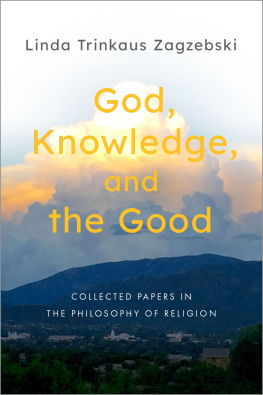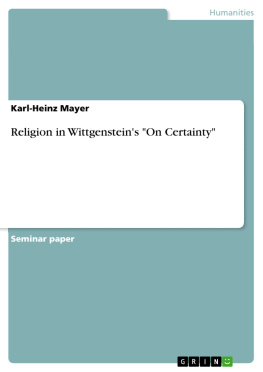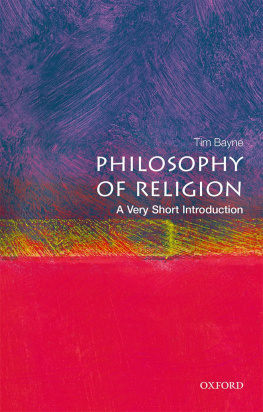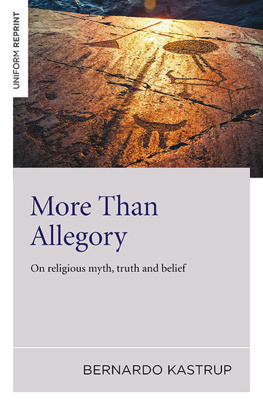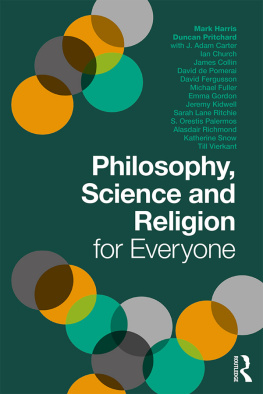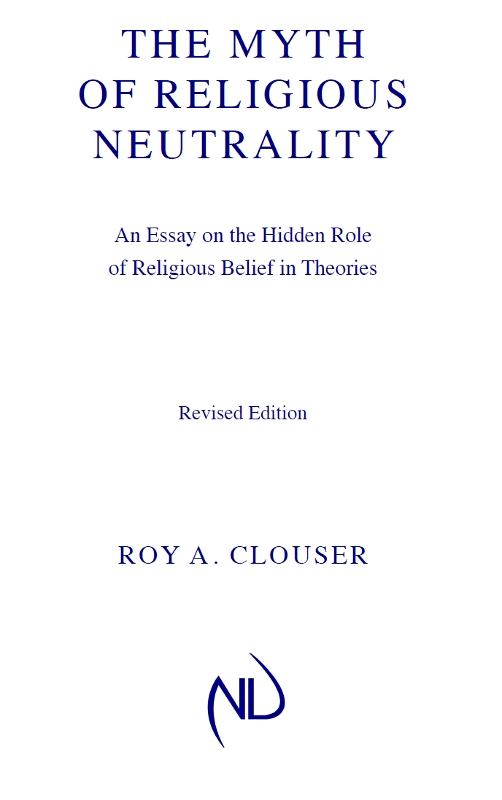
THE MYTH OF RELIGIOUS NEUTRALITY
An Essay on the Hidden Role of Religious Belief in Theories
Revised Edition
Roy A. Clouser
University of Notre Dame Press
Notre Dame, Indiana
Copyright 2005 by University of Notre Dame
Notre Dame, Indiana 46556
www.undpress.nd.edu
All Rights Reserved
E-ISBN: 978-0-268-07701-3
This e-Book was converted from the original source file by a third-party vendor. Readers who notice any formatting, textual, or readability issues are encouraged to contact the publisher at
CONTENTS
Back in the early 1960s someone whose name I cant recall wrote a review of Dooyeweerds four-volume magnum opus, A New Critique of Theoretical Thought. The reviewer acknowledged the vast scope, enormous erudition, and striking originality of that work, but nevertheless closed with a wry observation. He commented that discovering Dooyeweerds work in the present philosophical climate was analogous to finding a huge oak tree in the middle of a desert. Although he couldnt help being impressed by the oak, he said, he was left with the even stronger feeling of puzzlement as to what on earth it was doing there.
In this book I try to plant an oasis around the oak so as to diminish the wonder that its there, and thus allow the readers attention to be focused where it belongs: on the most original philosophical theory since Kant.
This second edition has allowed me to clarify points that were misunderstood, reply to objections, and offer more detailed arguments for the books main claims. The largest changes are to be found in are more complete.
I want to thank a number of people who aided these improvements. Dirk Stafleu and Gerald Barnes read and commented on the entire ms., while Walter Hartt, Bruce Wearne, and Martin Rice made valuable suggestions about a number of issues. I wish also to thank Luz Mara Garca de la Sienra for her excellent work in organizing and typesetting the text.
The first edition of this work was dedicated to Professor Dooyeweerd, who endured many interviews with me at his home for four months, and to my wife, Anita, who edited it. I now wish to rededicate this revised edition not only to them, but also to my mentors over many years:
William White
Robert Rudolph
T. Grady Spires
Johan Vander Hoeven
James Ross
Without their influence, patience, and instruction this work would not have been possible.
Roy Clouser
Spring 2005
This book offers a radical reinterpretation of the general relations between religion, science, and philosophy.
Despite the fact that the idea of those relations which is defended here is virtually unknown among professionals in these three areas, it is not historically new. It can trace its lineage through the thought of John Calvin and back to the Bible itself. However, it is an element of Calvins thought that has not been preserved by the Protestant tradition, and is based on biblical teaching that has received short shrift by the vast majority of Jewish, Christian, and Muslim thinkers. Nevertheless, after undergoing a renaissance led by the Dutch Calvinists Groen Van Prinsterer and Abraham Kuyper in the nineteenth century, this idea was given an impressive development in the work of the twentieth-century philosophers Dirk Vollenhoven and Herman Dooyeweerd.
It is the thought of Dooyeweerd in particular that is reflected here, and is introduced in a way that is intended especially for those not already acquainted with its Dutch Calvinist background.
I am grateful to a number of people who have read the manuscript in part or whole and who made valuable suggestions for its improvement. These include Johan Vander Hoeven (Free University of Amsterdam), James Ross (University of Pennsylvania), Grady Spires (Gordon College), Danie Strauss (University of the Orange Free State, Bloemfontein), Paul Helm (University of London), Hendrik Hart (Institute for Christian Studies, Toronto), Rev. Richard Russell (St. Thomas a Becket Church, Bath), Jonathan Gold (West Liberty State College), Martin Rice (University of Pittsburgh), James W. Skillen (Association for Public Justice, Washington, D.C.), and Carole Roos, my editor at the University of Notre Dame Press.
Others were also of aid and comfort in their own special way: Dr. Charles Stephenson, Dale and Lorraine Fleming, the late Bea Shemeley, John and Audrey Van Dyk, Gil Hunter, Arnold Olt, and the late Peter Steen.
I also wish to express my thanks to several institutions for their support at various stages of the research and writing: to the University of Pennsylvania for a Harrison Fellowship, to the Free University of Amsterdam for two travel grants, and to the Institute for Advanced Christian Studies and the Andreas Foundation for writing grants.
But above all, I want to express my deepest gratitude to the two people whose help was of the greatest significance to this work. The first is the late Herman Dooyeweerd, who endured lengthy conferences with me at his home, two to three times a week, for a total of four months; the second is my dear wife, Anita, whose editing of the entire manuscript was invaluable. It is to them that this work is affectionately dedicated.
INTRODUCTION
When we consider what religion is for mankind and what science is, it is no exaggeration to say that the future course of history depends upon the decision of this generation as to the relations between them.
Alfred North Whitehead
To what extent does religious belief make a difference to the ways people understand and conduct their lives?
The popular answer is that it all depends on how religious a person is. It makes virtually no difference at all for an atheist, while a fanatic thinks and cares about little else. The popular answer then sees the majority of people as falling between these two extremes, and it takes religion to deal mostly with morality and a persons eternal destiny rather than with the bulk of the affairs of life. Thus most of the affairs of day-to-day life are seen as neutral with respect to religious belief.
As a result of investigating religious belief and its influences for almost fifty years, I have become convinced that these popular opinions are completely mistaken. Instead, I find that religious belief is the most powerful and influential belief in the world. I further find that religious belief has the single most decisive influence on everyones understanding of the major issues of life ranging across the entire spectrum of human experience. Moreover, I find it exercises such influence upon all people independently of their conscious acceptance or rejection of the religious traditions with which they are acquainted.
The enormous influence of religious beliefs remains, however, largely hidden from casual view. Its relation to the rest of life is like that of the great geological plates of the earths surface to its continents and oceans. The movement of these plates is not apparent to an eyeball inspection of any particular landscape and can only be detected with great difficulty. Nevertheless, so vast are these plates, so stupendous their power, that their visible effectsmountain ranges, earthquakes, and volcanic eruptionsare but tiny surface blemishes compared with the force of the mighty plates themselves. Similarly, the great historic traditions of religious teaching, and the institutions devoted to their preservation, are merely the surface effects of religious belief, which is a vaster and more pervasive force than all of them put together.
Among the reasons this influence is so often missed is that people are prone to two alluring mistakes about religious belief. One is to suppose that all the major religious traditions are basically like the one theyre best acquainted with. The other is to suppose that the likeness between religious traditions must lie in their most obvious and outstanding features. These two mistakes serve to keep hidden from view the true nature of religious belief, and thus most of its influence.
Next page


